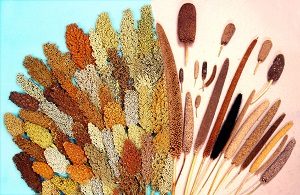Background
For centuries, millets were the staple food crops in India, but in more recent times they have been replaced by varieties of wheat, rice and maize despite them being much less nutrient dense than most millets. Millets are types of small-grained cereals that are very drought and heat tolerant and are considered a valuable food crop to cope with climatic change. Despite the history of millets there are few sets of data which have brought together the evidence on the association between millet consumption and health.
| Objectives
To undertake systematic reviews and linked meta-analyses to assess the impact of millet consumption on:
In addition to review in vitro methods for assessing iron bioaccessibility/bioavailability in millets. All of the papers had a primary focus on the diet-responsive non-communicable diseases in India. Outcomes and Impact The following papers were published as a key outcome of the work: Anitha, S., Givens, D. I., Botha, R., Kane-Potaka, J., Sulaiman, N. L. B., Tsusaka, T. W., Subramaniam, K., Rajendran, A., Parasannanavar, D. J. and Bhandari, R. K. (2021). Calcium from finger millet: A Systematic review and meta-analysis on calcium retention, bone resorption, and in vitro bioavailability. Sustainability 13: 8677. Sulaiman, N., Givens, D. I. and Anitha, S. (2021). A Narrative Review: In-vitro methods for assessing bio-accessibility/bioavailability of iron in plant-based foods. Frontiers in Sustainable Food Systems, 5:727533. Anitha, S., Givens, D. I., Subramaniam, K., Upadhyay, S., Kane-Potaka, J., Vogtschmidt, Y. D., Botha, R., Tsusaka, T.W., Nedumaran, S., Hemalatha, R., Rajendran, A., Parasannanavar, D. J., Vetriventhan, M. and Bhandari, R. K. (2022) Can feeding a millet-based diet improve the growth of children? – A systematic review and meta-analysis. Nutrients 14: 225. Anitha, S., Tsusaka, T. W., Botha, R., Kane-Potaka, J., Givens, D. I., Rajendran, A. and Bhandari, R. K. (2022). Are Millets more effective in managing hyperlipidaemia and obesity than major cereal staples? A Systematic Review and Meta-Analysis. Sustainability 14: 6659. Anitha, S., Tsusaka, T.W., Botha, R., Givens, D.I., Rajendran, A., Parasannanavar, D.J., Subramaniam, K., Bhandari, R.K. and Kane-Potaka, J. (2024) Impact of regular consumption of millets on fasting and post-prandial blood glucose level: a systematic review and meta-analysis. Front. Sustain. Food Syst. 7:1226474 Anitha, S., Tsusaka, T.W., Givens, D.I., Kane-Potaka, J., Botha, R., Sulaiman, N.L.B., Upadhyay, S., Vetriventhan, M., Rajendran, A., Parasannanavar, D.J., Longvah, T., Subramaniam, K., and Bhandari, R. K. (2024) Does millet consumption contribute to raising blood haemoglobin levels compared to regular refined staples: a systematic review and meta-analysis. Frontiers in Nutrition. 11:1305394. The papers attracted a lot of publicity in national newspapers in the UK but especially in India and have subsequently been highly cited in scientific papers related to millets. The results from the early papers also contributed to presentations at two major conferences in India. Almost all of the papers will contribute to a book on millets currently under preparation. Key university staff Professor Ian Givens Dr Lily Sulaiman (initially) Kim Vogtschmidt (PhD student, one paper). Dr Anitha Seetha was the project leader from ICRISAT.
|

